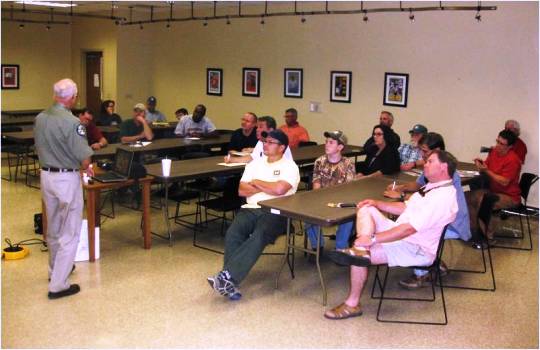Methods of Testing Your Soil/Pond
The most accurate method is to have a soil sample tested. Call your county cooperative extension service office and ask them to mail you a soil test kit (a box and a form). Take several soil samples from the pond bottom or along the shoreline of your pond--the more samples the better. Mix all the samples together and let the soil dry out. Check "fish pond" in the "crop grown" section of the form and send it off after filling the box with soil from your pond. The results will be sent back to you indicating how many tons of agricultural limestone you should apply. You really can't overlime a pond.
A less accurate way to determine your lime requirement is to locate your pond location on the soil-type map located on page 28 of the publication Managing Mississippi Ponds and Small Lakes. Liming rates range from zero in the Delta to 3 tons per acre in the Lower Coastal Plain along the Gulf Coast.
Another way of determining your lime requirement is to test your water for its alkalinity. Alkalinity test kits are inexpensive and easy to use. If your alkalinity is 20 or less, apply 2 tons of lime per surface acre. Waters with alkalinity less than 15 are in desperate need of lime. Waters with alkalinity between 20-30 will have a good response to fertilizer applications. The most you can increase your water's alkalinity is to 35-40 with proper lime application.
Applying Lime
Call your county farm cooperative store or garden supply store and determine if they will deliver and spread the amount of lime you need. Lime is cheap, but the transportation of it is not. Expect to pay between $40-60 per ton. All limestone sold in Mississippi must have a Relative Neutralizing Value (RNV) of at least 63 percent. The higher the RNV number, the better the lime in terms of purity and fineness of the grind in terms of particle size. Lime with a high RNV value dissolves quickly and changes the soil pH faster, so it is worth the money paid for it. Never use liquid lime, quick lime, hydrated lime, or other more potent liming agents. If the pH of the water is raised too quickly, you will kill your fish.
Lime should be added in the fall and winter so that it has enough time to react with the soil before you begin fertilizing in March or April. Ideally, limestone should be applied directly to the pond surface. If access is good around a pond, this is not a problem. If the spreader trucks can't get to the pond edge or on the levee, have them apply the lime on land adjacent to the pond where it will wash into the water. If the lime supplier has a minimum quantity you have to purchase that exceeds your lime requirement, don't worry--overliming will not hurt your pond. All it will do is prolong the time before the next lime application is needed.
Applying Fertilizer
Fertilization should begin in the spring when the water temperatures are 60F or higher. This usually means about March 15th in south Mississippi and April 1 in central and north Mississippi. Fertilization rates depend upon your soil type. Again, find your pond location on the Mississippi soil-type map located on page 28 of the publication Managing Mississippi Ponds and Small Lakes. Rates depend on the type of fertilizer you select to use. Fertilizers are sold containing different levels of nitrogen, phosphorus, and potassium. The product will have a number on it like "10-52-4", meaning it contains 10% nitrogen, 52% phosphorus, and 4% potassium. Freshwater ponds do not normally need more nitrogen. Phosphorus is the limiting nutrient.
Three types of fertilizer are recommended for Mississippi farm ponds:
- Liquid fertilizers, which must be stirred or shaken before application, with rates ranging from 1/2 to 1 gallon per acre per application. Dilute them with 2 parts water to 1 part fertilizer prior to application.
- Granular 0-46-0 (Triple Phosphate) fertilizer is the cheapest type, but it must placed on a platform to keep it off the bottom so it can slowly dissolve. If you throw 0-46-0 directly out into your pond, you are wasting two-thirds of it. 0-46-0 application rates range from 4-12 pounds per acre per application.
- Powdered fertilizers (10-52-4) will totally dissolve before they reach the bottom if thrown in water at least 2 feet deep. They are the easiest to use but will cost more than granular fertilizers. Powdered fertilizer rates range from 2-8 pounds per acre per application.

